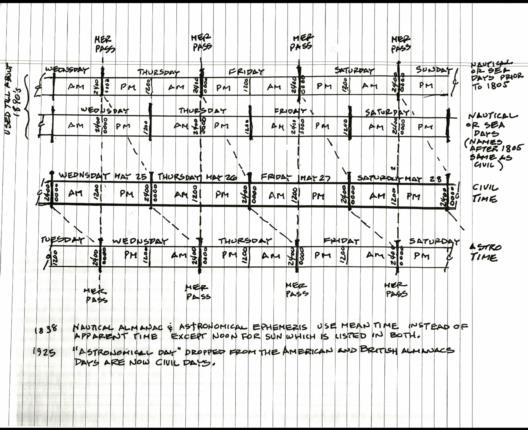
NavList:
A Community Devoted to the Preservation and Practice of Celestial Navigation and Other Methods of Traditional Wayfinding
From: Ed Popko
Date: 2018 May 23, 13:59 -0700
At the risk of embarrassing myself, I'm determined to understand how the various 19th century time conventions work and how almanac's dates/times align with them.
Frank is probably right -
The attached diagram tries to compare four daily time conventions: two versions of Nautical/Sea Days, Civil Time and Astronomical Time. Each share the same Meridian Passages (Mer Pass) as a reference.
The top two time-lines show Nautical/Sea Days pre- and post-1805. Both conventions begin 12 hours earlier than Civil Time for the same day. But in 1805, the BRN ordered logs to use Civil Day naming convention, thus, if I got it right, Saturday in the prior system is now split half-day Friday and half-day Saturday in the new post-1805 convention which is now aligned with Civil Day names.
The middle time-line is the conventional Civil Time convention.
The bottom time-line is Astronomical Time. Like Nautical Days, its day begins at Mer Pass but it's 12 hours later than Civil Time and a full 24 hours later than the pre-1805 Nautical/Sea convention.
Each of the four systems use a 2400 clock and AM PM marked though this is doubling up and unnecessary. You don't need both conventions to be clear.
There are two important footnotes from Frank's history of Nautical Almanacs. The goal here is to know which Almanac time convention was in use and how day names and ephemeris times correspond to each of the above conventions.
If this diagram is right, is it true navigators using Almanacs prior to 1925 need to be careful of how their dates align with the system they are using. For example, Nautical/Sea Days prior to 1805 would use thursday's ephemeris for ship board Friday sights? I'm sure this could not be, this would be an un-natural act.
This is the first time I have tried to graphically see how these conventions work. There are likely big mistakes so I appreciate any comments you might have.
Ed Popko







